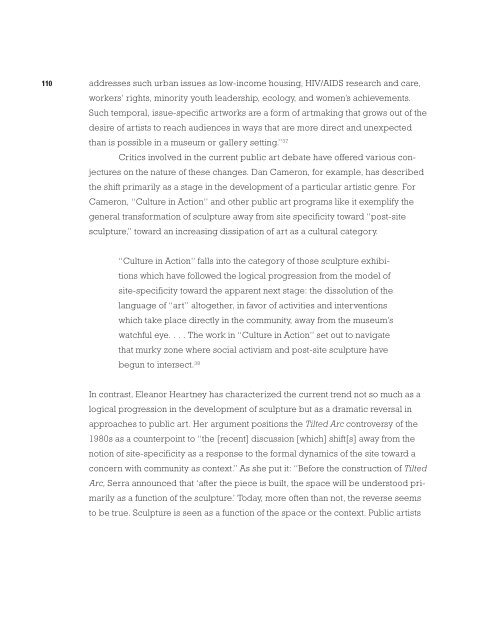ONE PLACE AFTER ANOTHER - Monoskop
ONE PLACE AFTER ANOTHER - Monoskop
ONE PLACE AFTER ANOTHER - Monoskop
You also want an ePaper? Increase the reach of your titles
YUMPU automatically turns print PDFs into web optimized ePapers that Google loves.
110<br />
addresses such urban issues as low-income housing, HIV/AIDS research and care,<br />
workers’ rights, minority youth leadership, ecology, and women’s achievements.<br />
Such temporal, issue-specific artworks are a form of artmaking that grows out of the<br />
desire of artists to reach audiences in ways that are more direct and unexpected<br />
than is possible in a museum or gallery setting.” 37<br />
Critics involved in the current public art debate have offered various conjectures<br />
on the nature of these changes. Dan Cameron, for example, has described<br />
the shift primarily as a stage in the development of a particular artistic genre. For<br />
Cameron, “Culture in Action” and other public art programs like it exemplify the<br />
general transformation of sculpture away from site specificity toward “post-site<br />
sculpture,” toward an increasing dissipation of art as a cultural category.<br />
“Culture in Action” falls into the category of those sculpture exhibitions<br />
which have followed the logical progression from the model of<br />
site-specificity toward the apparent next stage: the dissolution of the<br />
language of “art” altogether, in favor of activities and interventions<br />
which take place directly in the community, away from the museum’s<br />
watchful eye. ... The work in “Culture in Action” set out to navigate<br />
that murky zone where social activism and post-site sculpture have<br />
begun to intersect. 38<br />
In contrast, Eleanor Heartney has characterized the current trend not so much as a<br />
logical progression in the development of sculpture but as a dramatic reversal in<br />
approaches to public art. Her argument positions the Tilted Arc controversy of the<br />
1980s as a counterpoint to “the [recent] discussion [which] shift[s] away from the<br />
notion of site-specificity as a response to the formal dynamics of the site toward a<br />
concern with community as context.” As she put it: “Before the construction of Tilted<br />
Arc, Serra announced that ‘after the piece is built, the space will be understood pri-<br />
marily as a function of the sculpture.’ Today, more often than not, the reverse seems<br />
to be true. Sculpture is seen as a function of the space or the context. Public artists

















